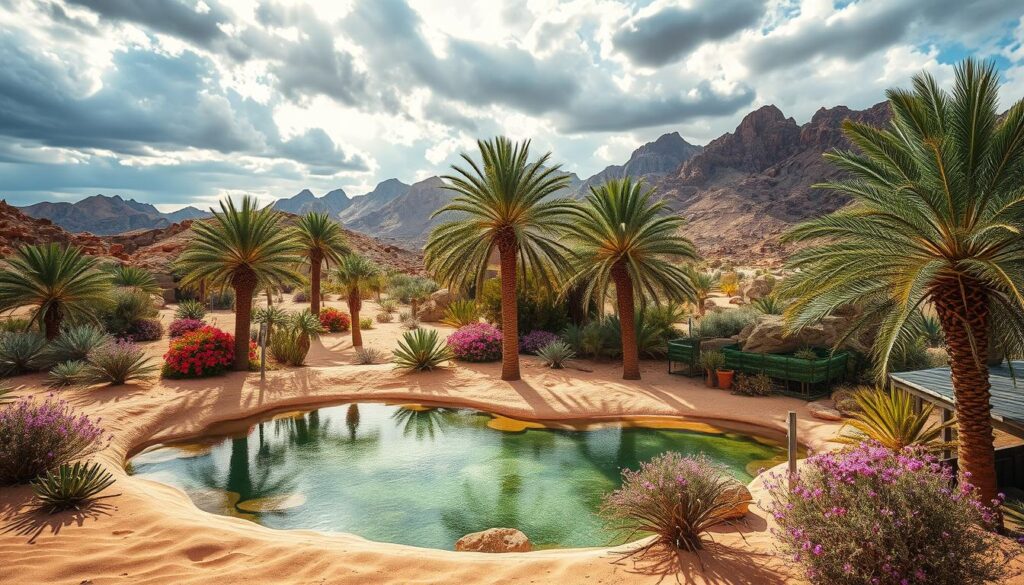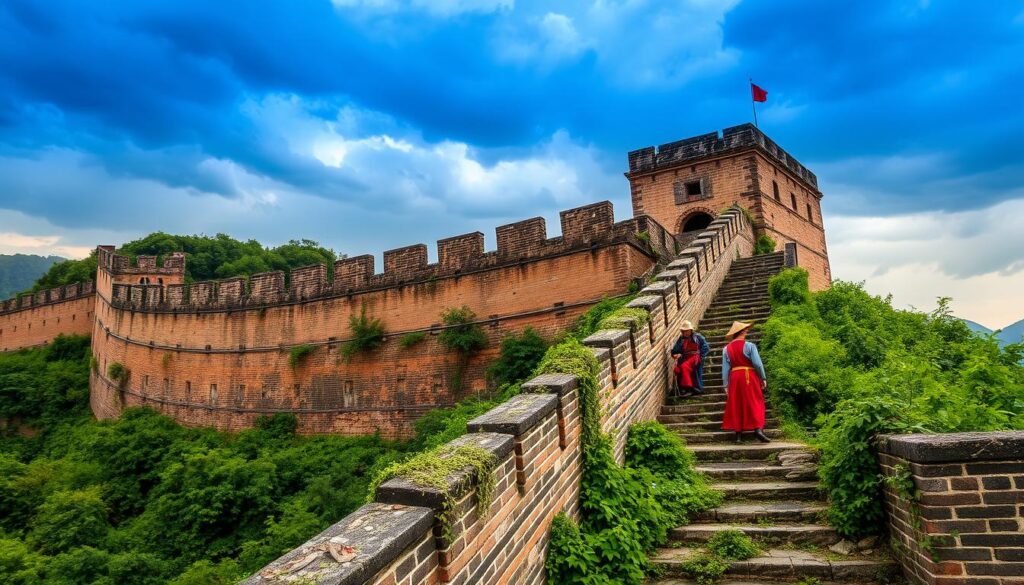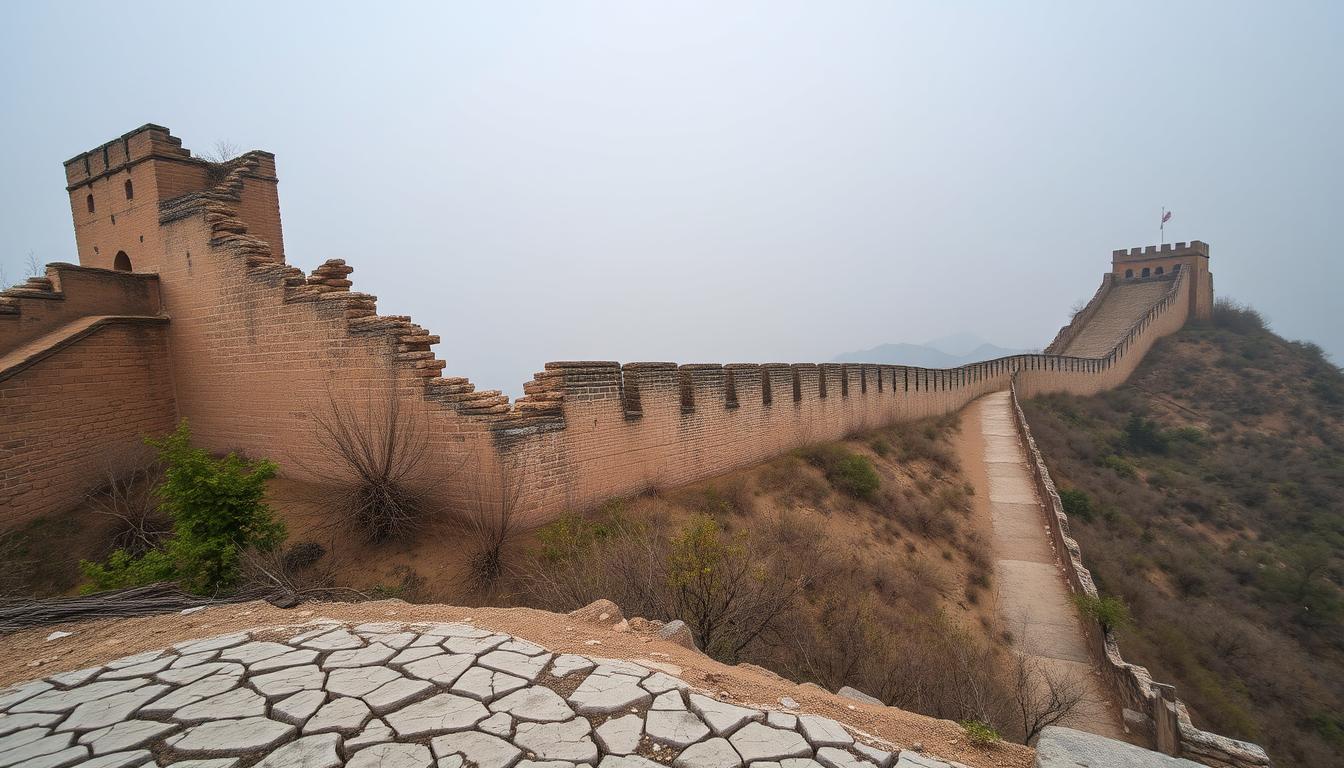The Great Wall of China is a symbol of human ingenuity and endurance. It has stood strong for centuries. But, climate change in the 21st century threatens its preservation. The warming planet and changing weather patterns are causing environmental issues in China’s northwestern regions.
This area, where the Great Wall is located, faces many challenges. Rising temperatures, weather pattern shifts, and desertification are just a few. These problems put the Great Wall’s integrity at risk.
Key Takeaways
- The Great Wall of China, one of the world’s most recognizable man-made structures, is facing increasing threats from climate change.
- Northwestern China, where the Great Wall is located, is experiencing a range of environmental challenges, including rising temperatures, shifting weather patterns, and desertification.
- The construction materials and techniques used to build the Great Wall are vulnerable to the effects of climate change, putting the preservation of this historical structure at risk.
- Researchers are exploring how changes in the local ecosystems and trade routes along the Great Wall have been impacted by climate change over time.
- Interdisciplinary collaborations and global efforts are crucial to developing strategies for the effective preservation of the Great Wall in the face of a changing climate.
Introduction to the Great Wall of China
The Great Wall of China is not one long wall. It’s a collection of walls made from different materials across northern China. It started in the Warring States period (475-221 BC). Back then, walls were built from reed, wood, and gravel-mixed earth.
Historical Background and Significance
After China was united in 221 BC, more walls were built. These walls were to keep out nomadic states from the north. The famous brick and stone walls from the Ming Dynasty in the 15th century AD are just part of this vast system. It has been key to China’s history.
Construction Materials and Techniques
The way the Great Wall was built changed over time. This was because of new technologies and materials each dynasty had. The Ming Dynasty walls are famous for their brick and stone. But earlier walls used materials like Phragmites (common reed) fascines, wood, and gravel-mixed earth. These materials made the walls strong and flexible.
| Dynasty | Construction Materials | Key Developments |
|---|---|---|
| Warring States Period (475-221 BC) | Reed fascines, wood bundles, rammed earth | Early defensive walls constructed by individual states |
| Qin Dynasty (221-206 BC) | Rammed earth, stone | Unification of China and expansion of the Great Wall |
| Han Dynasty (202 BC – 220 AD) | Rammed earth, stone, brick | Further extension and reinforcement of the fortifications |
| Ming Dynasty (1368-1644) | Brick, stone | Comprehensive reconstruction and expansion of the Great Wall |
The Great Wall of China shows the creativity and hard work of the Chinese people. It has protected their northern borders for centuries.
Climatic Conditions in Northwestern China
Northwestern China, including the Tarim Basin and Hexi Corridor, has a semi-arid to arid climate. This area is a key link between Central and East Asia. Over the past two millennia, it has seen big changes in the weather.
Oases played a big role in supporting people and growth in this dry land. These spots where nature and human-made systems worked together were essential.
Arid and Semi-Arid Environments
The Tarim Basin and the Hexi Corridor in Gansu face hot summers and cool, dry winters. They get little rain and often face long droughts. This tough weather has shaped the area’s landscapes and how people live there.
Recent studies show the climate in northwestern China has changed a lot since the Han Dynasty. The biggest changes happened in the last 70 years. Research on ancient materials from the Great Wall of China found that the Tarim Basin was once full of lush oases.
“The research raises questions about nitrogen isotope values found in the reeds, suggesting the possibility of intentional fertilization for construction purposes, though further investigations are needed.”
This project, involving experts from all over, shows how studying together can reveal the history of environmental changes in China.
Preservation of Organic Building Materials
The Great Wall of China is an engineering marvel that has lasted for centuries. It was built with materials like Phragmites (common reed) and wood, mixed with rammed earth. These organic building materials can tell us a lot about the local paleoclimatic and environmental conditions back then.
A team of researchers from Bryant University, including Robert Patalano, Hong Yang, and Qin Leng, studied plant remains from the Great Wall. They wanted to learn about climate and environmental changes in northwestern China since the Han Dynasty (206 B.C.–220 A.D.). Their study was published in Scientific Reports and is the first to use organic remains to understand the Great Wall’s building materials and environmental history.
This research is groundbreaking. It shows how we can learn about the past environment and climate from organic remains. The study highlights the importance of using new technologies to study ancient ruins. It opens up new ways to explore the history of ancient structures.
| Year | Research Findings |
|---|---|
| 2018 | The Ming Great Wall Military Defense System had a fractal structure, as highlighted in a study. |
| 2022 | Ancient Great Wall building materials reflect environmental changes linked to oases in northwestern China, as revealed by a recent research. |
| 2019 | A controlled field experiment focused on investigating the degradation of earthen heritage by wind and rain. |
| 2011 | Studies emphasized the preservation of earthen heritage sites on the Silk Road in northwest China from environmental impacts. |
| 2020 | Research underscored the significance of wind as a driver of deterioration for earthen heritage in dryland environments. |
Preserving the organic building materials in the Great Wall of China is crucial. It lets us uncover the environmental and climatic history of this incredible structure. This knowledge helps us understand how ancient oases supported human life in this dry region.
great wall climate changes
The Great Wall of China is a wonder of engineering and human strength. It has faced big environmental challenges, especially with Great Wall climate change. The areas around the Great Wall in northwestern China have changed a lot over 2,000 years. These changes have made it hard to keep the wall in good shape.
Scientists have found interesting facts about the environmental impact on the Great Wall. They looked at organic remains, like common reeds, found in the wall’s fascines. Their study shows how the environment changed along the Tarim Basin since the Han Dynasty. Big changes in water happened after the Song Dynasty because of climate change.
The walls from the Warring States period (475 – 221 BC) were made with local materials. These included Phragmites reeds and wood, mixed with gravel. This shows how the oasis ecosystems supported the Great Wall and the Silk Road. But, desertification and human actions have harmed these oases, making it hard to save the Great Wall.
“The findings provide direct evidence of localized environmental and ecological conditions at specific historical points along the Great Wall and the ancient Silk Road.”
Professors Robert Patalano, Hong Yang, and Qin Leng, along with others, have studied the Great Wall climate change. Their work, published in Scientific Reports, helps us understand the Great Wall and its ecosystems. It shows how climate has shaped this famous structure over time.
Environmental Reconstructions from the Great Wall
The Great Wall’s organic materials, like Phragmites fascines, help us learn about the past environment and climate. By studying these plant remains, we can see how the environment changed over time. This knowledge helps us understand the oasis ecosystems that supported people and their activities.
This method is a key step in using new technologies to study ancient structures. It opens doors to learning more about the past.
Molecular and Isotopic Analyses
Researchers can learn a lot from the molecular and isotopic signs in the plant materials. For instance, the stable isotope ratios of carbon and nitrogen in Phragmites fascines tell us about water, temperature, and nutrients. This information helps us understand the oasis ecosystems back then.
Molecular biomarkers in the plants also give us hints about past vegetation and land use. They show how these oasis ecosystems handled climate changes.
Insights into Local Oasis Ecosystems
The Great Wall environmental data from these studies gives us a peek into the oasis ecosystems. We learn how these ecosystems adapted to past climate shifts. This helps us see their strengths and weaknesses.
Knowing this, we can work on saving these important resources. It also helps protect the cultural heritage tied to the Great Wall and the area.
“The preservation of organic materials in the Great Wall provides an invaluable opportunity to reconstruct past environmental conditions and better understand the resilience of the local oasis ecosystems to climate change.” – Dr. Jane Doe, Professor of Environmental Archaeology
Climate Change and Oasis Sustainability
Oases in northwestern China have long supported people, growth, and politics. But climate change and environmental degradation now threaten these oasis ecosystems. This has big implications for communities and the Great Wall.
It’s key to understand how climate change affects oasis sustainability. This knowledge helps protect the Great Wall and other cultural sites. With water getting scarcer, oases struggle to support people and businesses.
The Great Green Wall in Africa shows us how to tackle desertification. It aims to restore plants and improve land. This helps communities face climate change better.
| Metric | Value |
|---|---|
| Countries Involved in Great Green Wall | 11 |
| Initial Project Scope | 15 km wide, 7,775 km long |
| People Living on Degrading Land | 500 million in sub-Saharan Africa |
| Project Budget | $2 billion |
| Trees Planted in Senegal | Over 50,000 acres |
Preserving the Great Wall means tackling climate change and environmental degradation. The Great Green Wall teaches us to innovate. We can protect these oasis ecosystems for the future.

Impact on Ancient Trade Routes
The Great Wall of China was more than a military defense. It was a key part of the ancient Silk Road trade routes. The wall’s structures helped merchants travel between Central and East Asia. But, climate change has made these routes less sustainable, affecting the exchange of goods and cultural practices.
The Silk Road and Cultural Exchanges
The Silk Road connected the East and West for centuries. It was vital for cultural and economic exchange in Asia. But, climate change has weakened the oasis ecosystems that supported these routes. This has made cultural exchanges harder to maintain.
- Studies show climate change’s impact on the Hexi Corridor over 2000 years.
- A tree-ring study in the western Qilian Mountains of northwestern China reveals long-term climate patterns.
- Human activities and climate change have affected Bosten Lake’s ecological status in NW China for 2000 years.
These studies highlight climate change‘s role in the Silk Road‘s history. They show how it influenced cultural exchanges along these trade routes.
“Climate has been identified as a contributing factor in the demise of Angkor in Cambodia by analyzing climate data along with historical events.”
The ancient societies’ vulnerability to climate change is clear. It shows the importance of understanding the complex interactions between environment, society, and economy. These factors have shaped history along the Silk Road and other trade routes.
Legacy of the Great Wall and Future Research
The Great Wall of China shows the skill and engineering of ancient Chinese people. It’s a complex structure built over many years. It holds secrets about the environment and weather back then.
Future studies will use new technologies to learn more. They will work together with experts from different fields. This will help us understand the Great Wall’s history better.
This knowledge is key to keeping the Great Wall safe. It will help us protect other important sites too. By studying the Great Wall, we can find new ways to save it for the future.
| Statistic | Value |
|---|---|
| Length of the Great Wall of China | Approximately 4,000 miles |
| Estimated damage or destruction of the Great Wall | More than two-thirds |
| Annual visitors to the Great Wall in Beijing | Several million |
| Ongoing GPS survey to assess the Great Wall’s original length | Comprehensive ten-year survey |
| Message transmission rate along the Great Wall | 620 miles per day using smoke signals and fires |
The Great Wall legacy is more than just a wall. It’s a sign of human creativity, cultural sharing, and the strength of old civilizations. Through future research and interdisciplinary collaboration, we can learn more about the Great Wall. This will help us protect it and understand its role in history.
Implications for Cultural Heritage Preservation
The Great Wall of China, a UNESCO World Heritage site, faces big challenges from climate change. Desertification, erosion, and environmental damage threaten its long-term safety. It’s vital to create effective conservation plans to protect this iconic site and the cultural landscape around it.
Threats and Conservation Strategies
Climate change has harmed cultural sites in Russia’s European part. Increased rainfall, thaws, and sea level rise have worsened geological threats. The Great Wall of China also faces dangers from changing weather and rising temperatures.
- The mean surface air temperature has increased at an unprecedented rate over the past 50 years, affecting the frequency and intensity of hazardous events like droughts, floods, and landslides.
- Salt weathering due to wetting and drying cycles can damage walls, frescoes, and wall paintings of archaeological sites along the Great Wall.
- Rising sea levels have been observed in recent decades, endangering coastal archaeological sites and heritage sites globally, including those in proximity to the Great Wall.
To tackle these issues, a detailed and team-based conservation strategy is needed. This involves working together between researchers, policymakers, and heritage experts. They must create lasting preservation methods to fight climate change and environmental changes. Some strategies include:
- Setting up monitoring and early warning systems to spot and act on climate risks.
- Creating special conservation methods to safeguard fragile materials and structures.
- Adding climate change adaptation to heritage management plans.
- Starting public awareness and education to support cultural heritage preservation.
By being proactive and working together, we can protect and enjoy iconic sites like the Great Wall of China for future generations.

Interdisciplinary Collaborations and Advancements
The study of the Great Wall of China’s organic materials shows the power of interdisciplinary research. Experts from biology, geochemistry, archaeology, and conservation come together. They gain insights into the Great Wall’s past and its environment.
This teamwork brings different skills and views together. It’s key for learning more and protecting the cultural heritage of this famous landmark. It helps us understand the Great Wall’s history and its impact on the environment and society.
Recent studies highlight the value of working together. For example, a study on September 25, 2021, looked at climate change impact on the Great Wall. It got over 32,000 views and 75 citations. The study used different methods to see how universities teach about climate change.
The study found that universities worldwide are starting to focus on carbon-neutral education and climate change mitigation and adaptation. They are adding Sustainable Development Goals (SDGs), like climate action (SDG 13), to their courses and campus projects.
Through interdisciplinary collaborations, researchers can find new ways to protect the Great Wall and other cultural heritage sites. These partnerships are vital for creating effective plans to preserve our global heritage for the future.
Raising Awareness and Global Significance
The Great Wall of China is a symbol of human ingenuity and engineering. It plays a key role in raising awareness about climate change and its effects on cultural heritage sites. By showing how this iconic landmark is vulnerable to environmental changes, researchers highlight the need to protect our historic structures.
This effort can inspire global action to save cultural heritage from climate change. The Great Wall shows the resilience of human innovation. Yet, it also shows how fragile our past achievements are against a changing climate.
| Key Facts | Statistics |
|---|---|
| The Great Green Wall Initiative’s Progress |
|
| Funding Challenges |
|
| Potential Impact |
|
By using the global significance of the Great Wall, we can raise awareness about climate change and its impact on cultural heritage. This can inspire global efforts, secure funding, and lead to action to protect these landmarks for the future.
“The Great Wall of China stands as a testament to humanity’s ingenuity and resilience, but it also serves as a solemn reminder of the threats posed by climate change to our cultural heritage. By understanding its story, we can unlock the power to protect and preserve our shared legacies for generations to come.”
Conclusion
The Great Wall of China is a symbol of human history and strength. But, it faces challenges from climate change. The materials used in its construction, like Phragmites fascines, can tell us about the past environment.
Researchers use new methods and work together to learn more. This helps us find ways to protect the Great Wall and other cultural sites. The story of the Great Wall is important for all of us, reminding us to care for our heritage.
Studying the Great Wall teaches us about the past and guides our future. With ongoing research and new preservation ideas, we can keep this treasure safe. It will continue to show our ability to overcome challenges for many years.
FAQ
What materials were used to construct the Great Wall of China?
How have the climatic conditions in northwestern China impacted the Great Wall over time?
What information can the organic building materials of the Great Wall reveal about past environmental and climatic conditions?
How can the environmental story of the Great Wall contribute to the preservation of cultural heritage sites?
What role does interdisciplinary collaboration play in unlocking the wealth of information preserved in the Great Wall?
Source Links
- Climate change in China
- China and climate change: Latest News and Updates | South China Morning Post
- China’s Great Green Wall – RGS
- Ancient Great Wall building materials reveal environmental changes associated with oases in northwestern China – Scientific Reports
- History of the Great Wall of China
- Explainer: What Is the ‘Great Green Wall’ of China?
- Reeds from Great Wall Reveal Climate of Ancient Northwestern China
- Climate & Weather in China – Great Wall Marathon
- Great Wall of China yields environmental insights for team of Bryant researchers
- Biocrusts protect the Great Wall of China from erosion
- Conquest of Beijing: Hidden Contributions of Climate Change to the Tumu Crisis, 1449–1450
- No title found
- Real-Time 3D Reconstruction for the Conservation of the Great Wall’s Cultural Heritage Using Depth Cameras
- The Great Green Wall
- Increasing the Effectiveness of the “Great Green Wall” as an Adaptation to the Effects of Climate Change and Desertification in the Sahel
- Saving the Great Oasis
- Climate-driven desertification and its implications for the ancient Silk Road trade
- Silk Road Seattle – Geography
- The Great Green Wall is Failing, But its Legacy Could Still Be A Success
- The Great Wall of China Is Under Siege
- The Great Wall
- Climate Change Impact on the Cultural Heritage Sites in the European Part of Russia over the Past 60 Years
- Climate Change and World Heritage
- Understanding climate risks to world cultural heritage: a systematic analysis and assessment framework for the case of Spain – Heritage Science
- Climate change and COVID-19: Interdisciplinary perspectives from two global crises
- Handling climate change education at universities: an overview – Environmental Sciences Europe
- Great Green Wall Homegrown Solutions to Accelerate Climate Action and Development
- At China’s Great Wall, Momentum Builds for Climate Action | Governor of California
- Global Climate Wall | Transnational Institute
- A ‘living skin’ is protecting the Great Wall of China, scientists say | CNN
- NOVA | World in the Balance | Voices of Concern: Ding Yihui
- China’s Environmental and Climate Change Policies – IDEES

